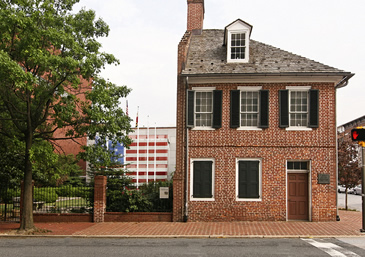
Courtesy of by fstopsue, from Flickr's Creative Common
The Chesapeake Bay Gateways and Watertrails Network (Chesapeake Gateways) is a system of over nearly 200 places located within the Chesapeake Bay watershed. Chesapeake Gateways tell the story of the connections between people and nature in the Chesapeake region through its historic sites and communities, trails, parks, wildlife refuges, maritime museums, and more. The Network’s goal is to help connect people to the natural and cultural heritage of the Chesapeake region. Each partner site contributes its own perspective on a Chesapeake component or theme so that, together, partners offer visitors a fuller range of authentic Chesapeake experiences on water and on land.
The Chesapeake Bay was home to many generations of American Indians before Europeans charted the area in the 1500s. Today, eleven recognized tribes of Virginia keep their cultures alive and thriving. Visit the Pamunkey Indian Reservation and find out more about that tribe’s history and museum. Riverbend Park is the site of the Virginia Indian Festival where people celebrate American Indian culture; it is also a popular place to go kayaking, canoeing, fishing, or hiking. Along the Patuxent River in Maryland, archeologists have found evidence of over 9,000 years of human habitation at what is now Jefferson Patterson Park and Museum. Its interactive visitor center, historical and garden tours, Indian Village, and educational archeological programs give visitors a chance to learn more about the Chesapeake Bay area and the people who once lived there. On the Potomac, visit Piscataway Park for more information about Maryland Indians and early colonial settlement. Piscataway Park is also included as another site in this travel itinerary. Use the Captain John Smith Chesapeake National Historic Trail to learn more about Chesapeake region American Indian communities, both historic and contemporary.
In early human history on the Chesapeake, the waterways served as transportation corridors. American Indians as well as Captain John Smith and his fellow colonists preferred bald cypress trees as boat building material. At Trap Pond State Park in Delaware, visitors can take pontoon boat rides, or paddle a canoe or kayak, to see up close the northern-most stands of bald cypress trees. Many of the Gateways Network partners offer opportunities to learn about maritime trades. At Annapolis Maritime Museum, learn how valuable the oyster industry was to the Chesapeake or take a ride on an historic oyster dredging vessel, the skipjack Nathan of Dorchester, or the Martha Lewis out of Havre de Grace, Maryland. Visit the Frederick Douglass-Isaac Myers Maritime Park in Baltimore to try your hand at the skill of boat caulking, a trade practiced by Frederick Douglass before he escaped slavery, and learn about African Americans in the maritime industry.
In the Chesapeake region, the Bay's many tributaries were often used as routes for escaping slaves. Harriet Tubman, born a slave on Maryland’s Eastern Shore, escaped to freedom and returned nearly 20 times to lead as many as 300 slaves northward. Visitors today can drive the 64-mile Harriet Tubman Underground Railroad Scenic Byway to learn about her life and the many historic places connected with her in Chesapeake Bay country.
South of the Byway, on Virginia’s Eastern Shore, is Onancock Historic District and Town Wharf , called the “Gem of the Eastern Shore”. Explored by Captain John Smith in 1607 and chartered in 1680, Onancock is one of King James’ original 12 royal ports in Colonies. Onancock today remains a working port for watermen and waterborne commerce while offering recreational boaters a unique port of call.
Early colonists, and many of the fledgling country’s most famous patriots, often sited their working plantations along rivers to facilitate commerce and trade for tobacco and other products. Today, visitors can arrive by boat or auto to tour Stratford Hall Plantation, built by Thomas Lee in the 1730’s. Lee descendants included signers of the Declaration of Independence, and Stratford Hall was the birthplace of Robert E. Lee. Also on the Potomac is the George Washington Birthplace National Monument and, on the Rappahannock River, George Washington’s Ferry Farm, his boyhood home.
Chesapeake river communities were later harassed by the British during the Chesapeake Campaign of the War of 1812. Learn about young America’s struggles against the world’s most powerful navy through the Star-Spangled Banner National Historic Trail. Trail sites include many Gateways Network partners, including Sotterley Plantation, the Havre de Grace Maritime Museum, North Point State Park and Baltimore’s Fort McHenry National Monument as well as Fort Boykin and Tangier Island in Virginia.
Whether learning about the diverse human history of the Chesapeake, or the natural beauty and bounty of the Bay, Chesapeake Gateways open a door for enjoyable and refreshing experiences.
The Chesapeake Gateways and Watertrails Network is located in Virginia, Maryland, Delaware, Pennsylvania, Washington, D.C., and West Virginia. For more information, visit the National Park Service Chesapeake Bay Office.
Tags
- chesapeake bay
- travel americas diverse cultures travel itinerary
- african american sites
- national register of historic places
- cultural and ethnic diversity
- european sites
- american indian sites
- delaware
- d.c.
- maryland
- new york
- pennsylvania
- virginia
- west virginia
- chesapeake gateways
- chesapeake bay
- chesapeake
Last updated: July 18, 2023
